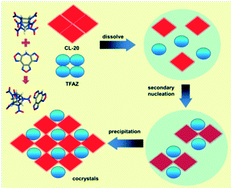Preparation of CL-20/TFAZ cocrystals under aqueous conditions: balancing high performance and low sensitivity†
Abstract
Cocrystals of hexanitrohexaazaisowurtzitane (CL-20) and 7H-trifurazano[3,4-b:3′,4′-f:3′′,4′′-d]azepine (TFAZ) in a 1 : 1 molar ratio were prepared by both slow evaporation and self-assembly methods. Structure determination showed that they belong to the monoclinic system (space group P21) with a crystal density of 1.932 g cm−3. The intermolecular hydrogen bonds and N–O⋯NO2 type interactions are demonstrated as the predominant driving forces in the cocrystal formation. Furthermore, the cocrystals were successfully synthesized by a self-assembly method using only water as a solvent under mild conditions and the product yield was up to 92.3%. The two types of cocrystals were fully characterized by powder X-ray diffraction, infrared spectroscopy and scanning electron microscopy. Moreover, the thermal behavior, sensitivity, and calculated detonation performance of the cocrystals were evaluated. The cocrystals exhibit good thermal stability (Td = 242.8 °C), low impact sensitivity (H50 = 42 cm) and friction sensitivity (Pf = 38%), high crystal density, and high calculated detonation velocity (9103 m s−1). This work opens up a new perspective in the environment-friendly preparation of energetic cocrystals on a large-scale, as well as providing potential low-sensitivity and high-energy explosives.



 Please wait while we load your content...
Please wait while we load your content...